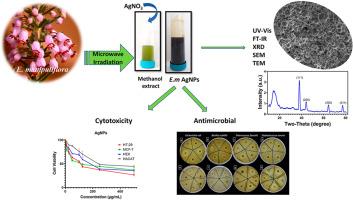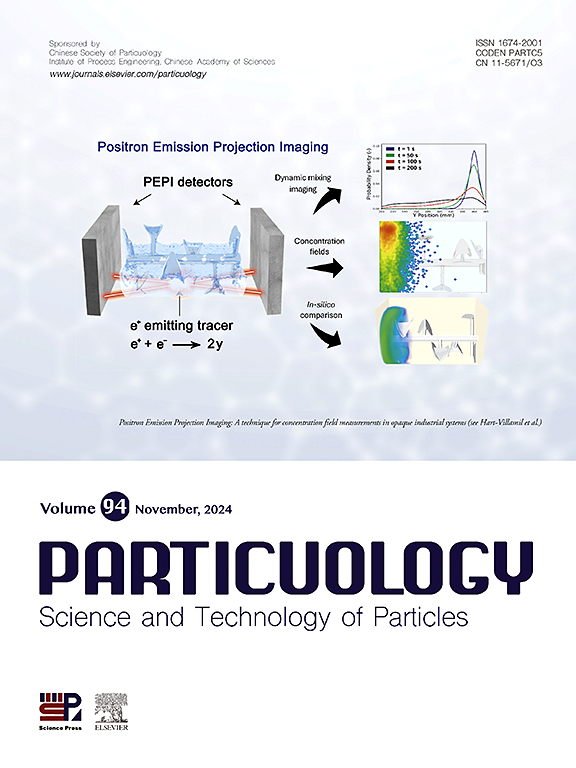探索微波辅助生物合成银纳米粒子的治疗潜力:关于抗癌和抗菌潜力的综合研究
IF 4.1
2区 材料科学
Q2 ENGINEERING, CHEMICAL
引用次数: 0
摘要
银纳米粒子(AgNPs)因其在生物医学中的潜在应用,尤其是其抗菌和抗癌特性而持续受到关注。在这方面,开发对环境友好且包含新来源的生物合成技术非常重要。本研究首次报道了利用 Erica manipuliflora Salisb.(E.m AgNPs)在微波辅助下绿色合成银纳米粒子。本研究评估了 E.m AgNPs 和 E. manipuliflora 提取物的抗癌和抗菌活性。使用紫外可见光谱、傅立叶变换红外光谱、X射线衍射、扫描电镜和透射电镜分析了E.m AgNPs的特性。紫外可见吸收光谱显示,E.m AgNPs 在 λmax = 425 nm 处出现特征峰。SEM 和 TEM 结果表明,纳米粒子呈球形,大小在 2.45 至 9.95 nm 之间。抗菌结果表明,与所有植物提取物(50 mg mL-1)(8.13-17.16 mm ZOI)相比,E.m AgNPs(50 mg mL-1)(8.4-21.1 mm ZOI)对革兰氏阳性菌(枯草杆菌、金黄色葡萄球菌、粪肠球菌)和革兰氏阴性菌(大肠杆菌)的抑制作用更强。在癌症细胞系(MCF-7 和 HT-29)和健康细胞系(HaCaT 和 HEK-293)中,E.m AgNPs 对 MCF-7 细胞的细胞毒性最高(IC50:87.22 μg mL-1)。正己烷提取物对所有细胞株的细胞增殖都有最有效的抑制作用,对 MCF-7 细胞的抑制作用最强(IC50:43.06 μg mL-1)。研究结果表明,E.m AgNPs 和 E. manipuliflora 提取物对病原菌菌株具有良好的抗菌活性,并具有潜在的抗癌活性。本文章由计算机程序翻译,如有差异,请以英文原文为准。

Exploring the therapeutic potential of microwave-assisted biosynthesized silver nanoparticles using Erica manipuliflora Salisb.: A comprehensive study on anticancer and antibacterial potentials
Silver nanoparticles (AgNPs) continue to attract interest due to their potential applications in biomedicine, especially in relation to their antibacterial and anticancer properties. In this respect, it is important to develop biosynthesis techniques that are environmentally friendly and include new sources. This is the first report on microwave-assisted green synthesis of silver nanoparticles using Erica manipuliflora Salisb. (E.m AgNPs). In this study, the anti-cancer and antibacterial activity of E.m AgNPs and E. manipuliflora extracts were evaluated. Characterization of E.m AgNPs were performed using UV–Vis spectroscopy FT-IR, XRD, SEM and TEM analyses. The UV–Vis absorption spectrum showed the characteristic peak of E.m AgNPs at λmax = 425 nm. The SEM and TEM results indicated that the nanoparticles were spherical and ranged in size from 2.45 to 9.95 nm. The antibacterial results, it was determined that E.m AgNPs (50 mg mL−1) (8.4–21.1 mm ZOI) caused more effective inhibition on both gram positive (Bacillus subtilis, Staphylococcus aureus, Enterococcus faecalis) and gram negative (Escherichia coli) bacteria compared to all plant extracts (50 mg mL−1) (8.13–17.16 mm ZOI). Among the cancer (MCF-7 and HT-29) and healthy (HaCaT and HEK-293) cell lines, E.m AgNPs exhibited the highest cytotoxicity against MCF-7 cells (IC50: 87.22 μg mL−1). The hexane extract was the most effective inhibitory extract on cell proliferation of all cell lines and showed the highest cell inhibition in MCF-7 cells (IC50: 43.06 μg mL−1). The results revealed that both E.m AgNPs and E. manipuliflora extracts showed promising antibacterial activity against pathogenic bacterial strains and had potential anticancer activity.
求助全文
通过发布文献求助,成功后即可免费获取论文全文。
去求助
来源期刊

Particuology
工程技术-材料科学:综合
CiteScore
6.70
自引率
2.90%
发文量
1730
审稿时长
32 days
期刊介绍:
The word ‘particuology’ was coined to parallel the discipline for the science and technology of particles.
Particuology is an interdisciplinary journal that publishes frontier research articles and critical reviews on the discovery, formulation and engineering of particulate materials, processes and systems. It especially welcomes contributions utilising advanced theoretical, modelling and measurement methods to enable the discovery and creation of new particulate materials, and the manufacturing of functional particulate-based products, such as sensors.
Papers are handled by Thematic Editors who oversee contributions from specific subject fields. These fields are classified into: Particle Synthesis and Modification; Particle Characterization and Measurement; Granular Systems and Bulk Solids Technology; Fluidization and Particle-Fluid Systems; Aerosols; and Applications of Particle Technology.
Key topics concerning the creation and processing of particulates include:
-Modelling and simulation of particle formation, collective behaviour of particles and systems for particle production over a broad spectrum of length scales
-Mining of experimental data for particle synthesis and surface properties to facilitate the creation of new materials and processes
-Particle design and preparation including controlled response and sensing functionalities in formation, delivery systems and biological systems, etc.
-Experimental and computational methods for visualization and analysis of particulate system.
These topics are broadly relevant to the production of materials, pharmaceuticals and food, and to the conversion of energy resources to fuels and protection of the environment.
 求助内容:
求助内容: 应助结果提醒方式:
应助结果提醒方式:


